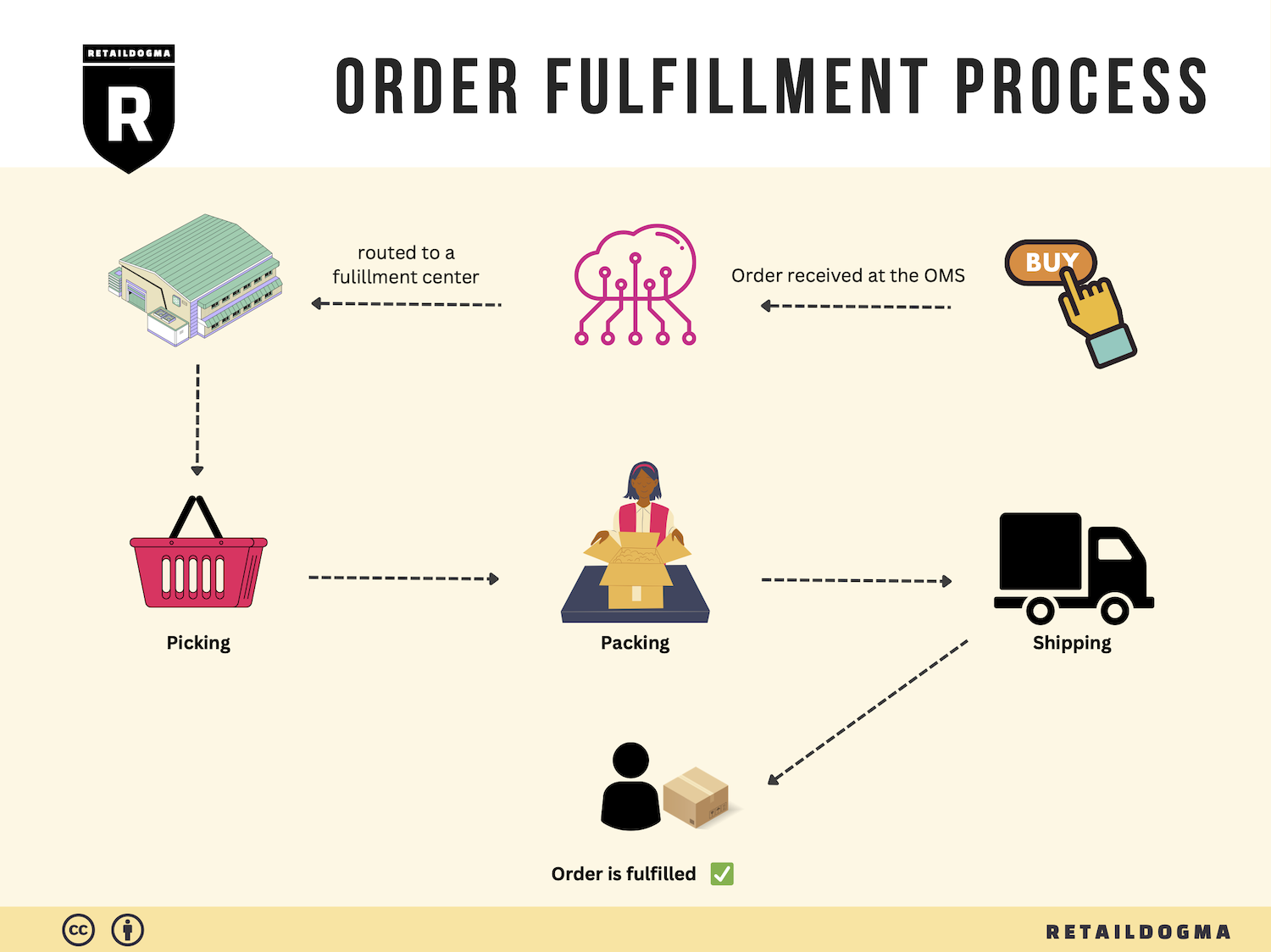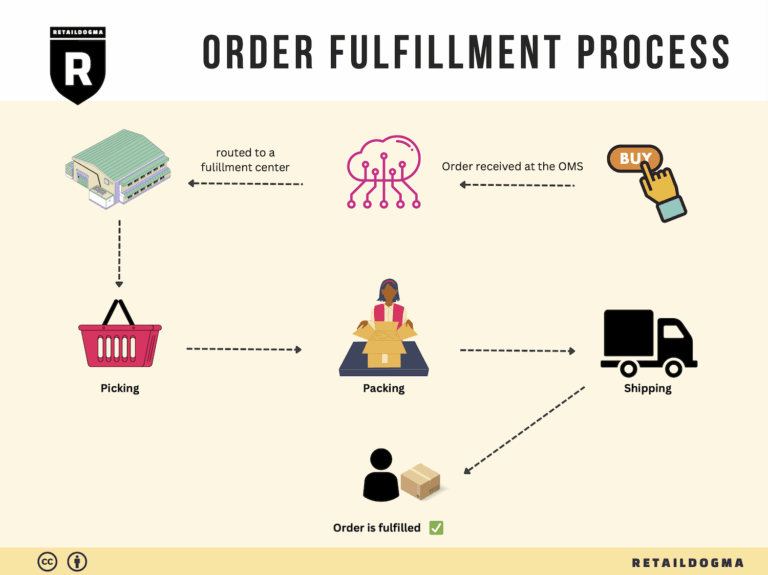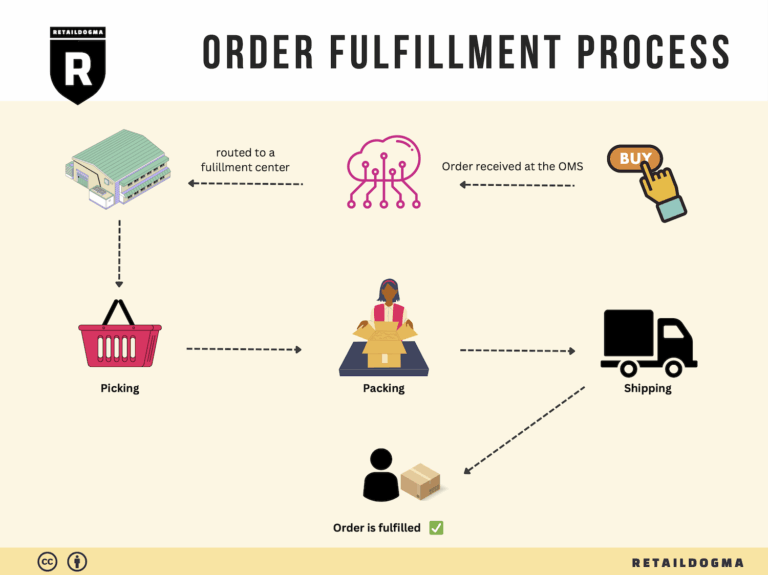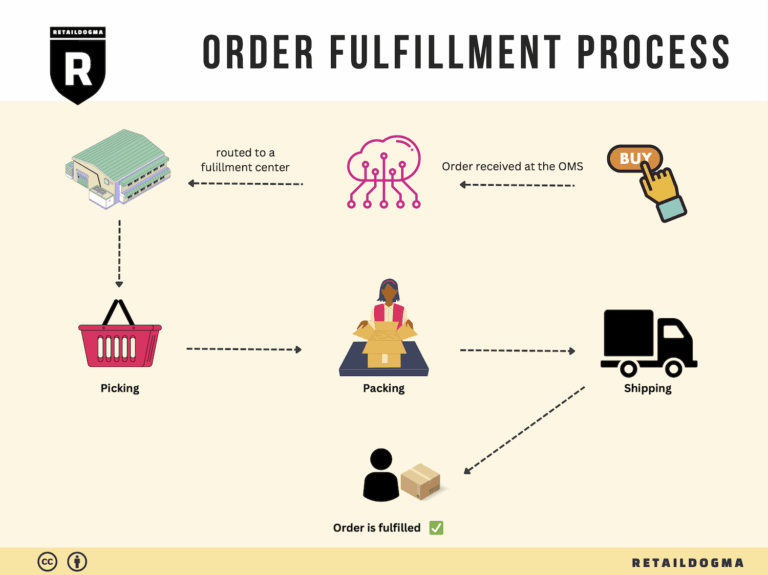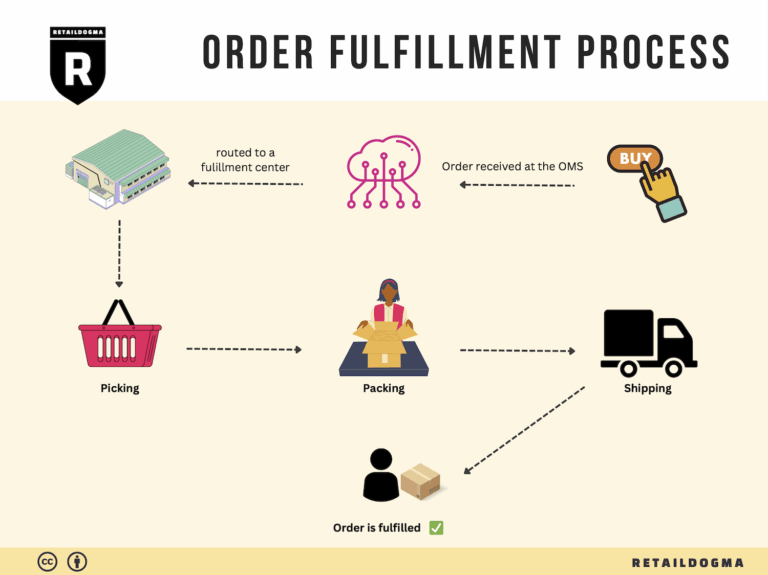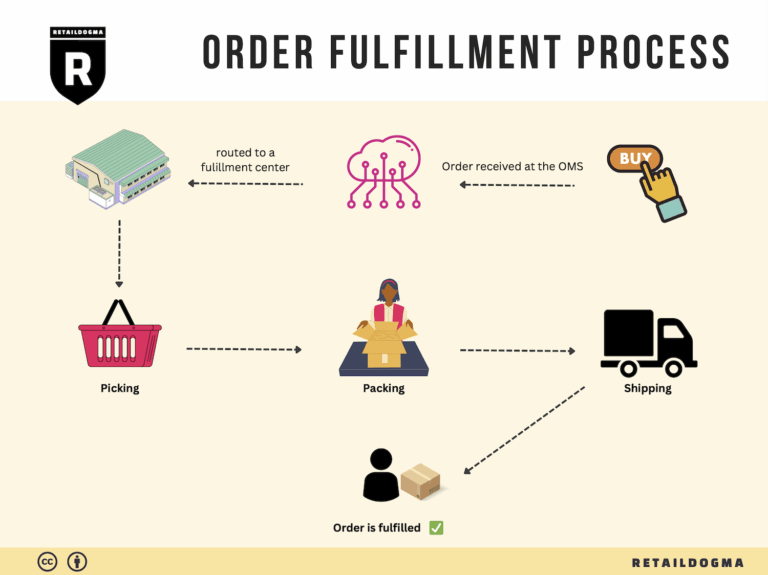Ecommerce Fulfillment Services: The Ultimate Guide (2025)
What is E-commerce Fulfillment? An Introduction for Growing Businesses
Understanding the Challenges of E-commerce Fulfillment
As your online business begins to grow, the excitement of increasing sales can quickly turn into an overwhelming experience—especially when it comes to packing and shipping orders. Managing fulfillment in-house may have worked during your initial stages, but as order volumes rise, so do the complexities of logistics. This is where effective e-commerce fulfillment becomes critical.
Fulfillment is simply the process of getting a product from your warehouse to your customer’s doorstep. It encompasses everything from inventory management and order processing to shipping and handling returns. For many businesses, mastering this process can be the difference between scaling successfully and struggling to meet customer expectations.
What This Guide Covers
In this guide, we will explore various fulfillment models available to e-commerce businesses, including Third-Party Logistics (3PL) and Fulfillment by Amazon (FBA). Each model has its own set of advantages and considerations, and understanding these will help you choose the right path for your business.
We will delve into the core services offered by fulfillment partners, such as warehousing, order picking and packing, shipping, and returns management. These services not only streamline operations but also enhance customer satisfaction, which is crucial for repeat business.
Choosing the right fulfillment partner is a vital decision for any growing business. We will provide insights on what to look for in a partner, including technology integration, scalability, and customer service capabilities. These factors can greatly influence your operational efficiency and overall growth trajectory.
Finally, we will discuss pricing structures associated with different fulfillment services. Understanding the cost implications will allow you to make informed financial decisions that align with your business goals.
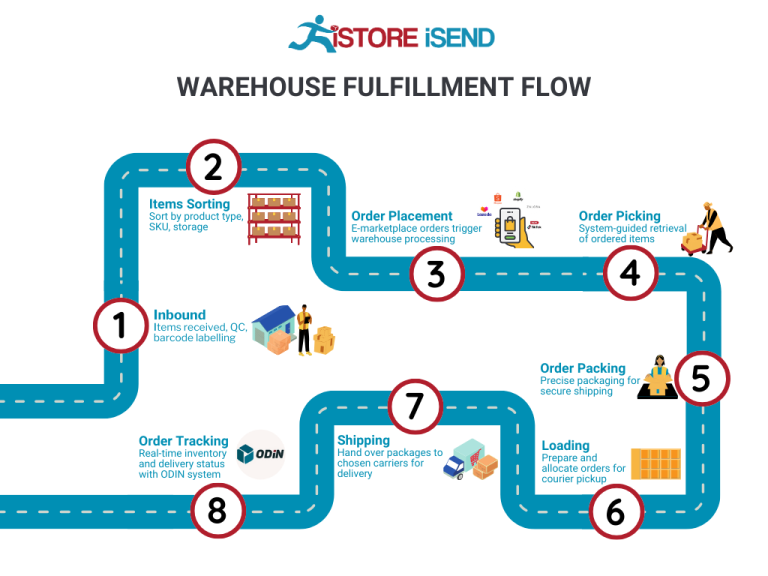
Empowering Your Logistics Decisions
The ultimate goal of this guide is to empower your business to make smart decisions about your logistics strategy. By gaining a comprehensive understanding of e-commerce fulfillment, you can optimize your supply chain, improve customer satisfaction, and ultimately drive growth. With the right knowledge and tools at your disposal, you can focus on what you do best—growing your business.
What You’ll Learn In This Guide
- What is E-commerce Fulfillment? An Introduction for Growing Businesses
- The Order Fulfillment Process: From ‘Buy’ Button to Customer’s Door
- Comparing Fulfillment Models: In-House vs. 3PL vs. Dropshipping
- A Deep Dive into Amazon FBA: Pros, Cons, and Who It’s For
- Core Services Offered by Fulfillment Centers
- How to Choose a Fulfillment Partner: A 6-Point Checklist
- Understanding Fulfillment Pricing: A Breakdown of Common Fees
- Frequently Asked Questions (FAQs) about Fulfillment
- Conclusion: Is Outsourcing Fulfillment the Right Move for Your Business?
- Important Disclaimer
The Order Fulfillment Process: From ‘Buy’ Button to Customer’s Door
1. Receiving Inventory
The first step in the order fulfillment process is receiving inventory. When your products arrive at the warehouse, they must be checked for accuracy against purchase orders and inspected for any damage. This is where the concept of SKU (Stock Keeping Unit) comes into play, as each item should have a unique SKU that allows for easy tracking and management.
Importance: Efficient receiving processes are crucial as they set the stage for the entire fulfillment operation. Accurate inventory checks ensure that your warehouse has the right products in the right quantities, minimizing discrepancies that can lead to stockouts or overstock situations. By leveraging technology, such as barcode scanners and inventory management software, you can streamline this process, ensuring quicker turnaround times and reducing human error.
2. Warehouse Storage
Once the inventory has been received and verified, the next step is warehouse storage. This involves placing the products in designated storage locations within the warehouse. Effective warehouse management systems (WMS) play a critical role here, helping you optimize space utilization and organize products based on demand and accessibility.
Importance: Proper storage not only enhances the efficiency of order picking but also impacts overall operational costs. By strategically locating high-demand items closer to the packing area, you can reduce the time it takes to fulfill orders. Additionally, a well-organized warehouse allows for better inventory control, enabling you to keep track of stock levels and minimize the risk of obsolescence or spoilage.
3. Order Picking
Order picking is the process of retrieving items from the warehouse to fulfill customer orders. This step typically involves generating pick lists, which are documents or digital notifications that specify the items and quantities needed for each order. Different picking methods, such as single order picking, batch picking, or wave picking, can be employed based on the volume and type of orders.
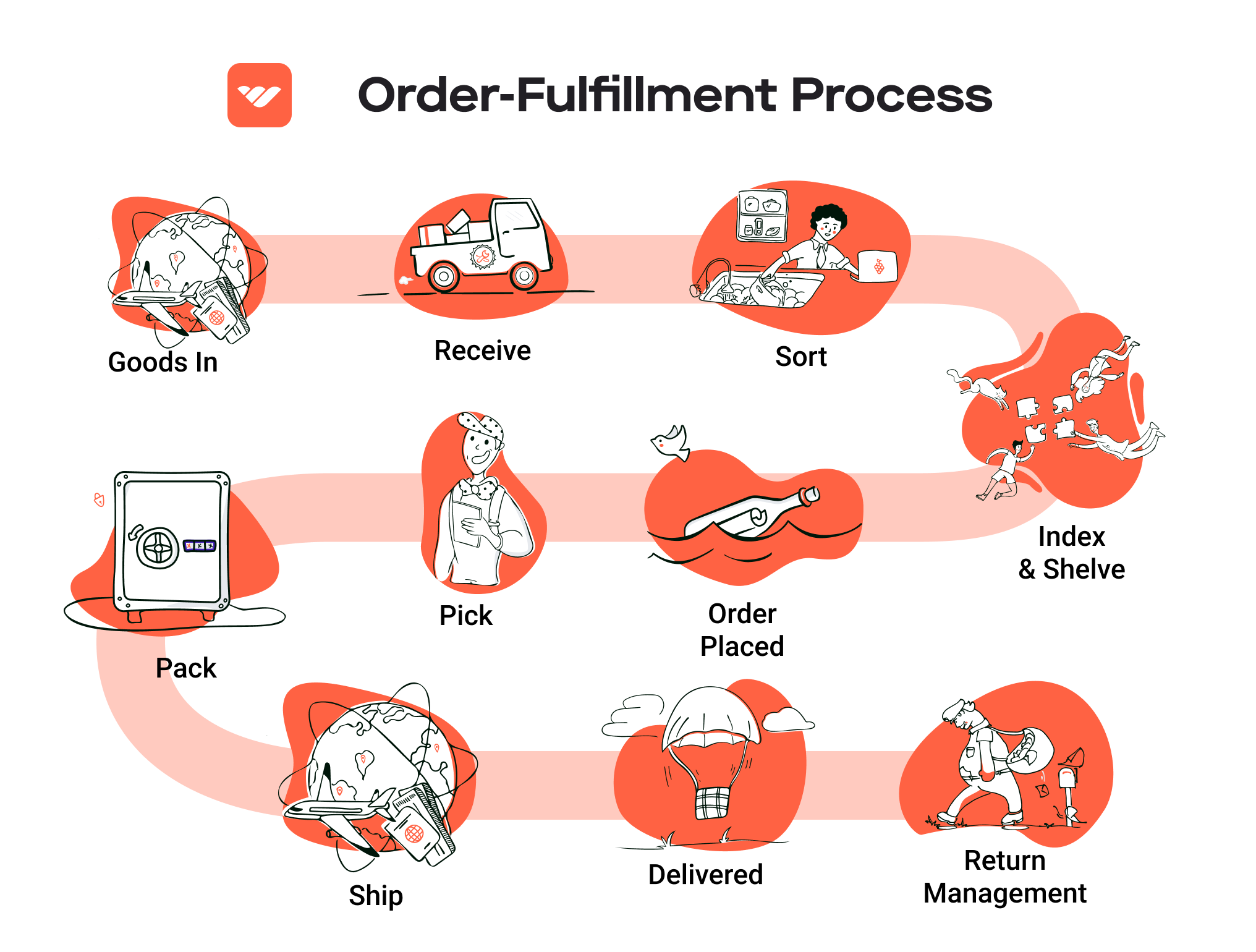
Importance: Efficient picking is vital for minimizing order cycle times and ensuring customer satisfaction. The faster and more accurately you can pick items, the quicker you can move on to the packing stage. Implementing technologies like pick-to-light systems or mobile scanning devices can enhance picking accuracy and speed, leading to improved operational performance and customer loyalty.
4. Order Packing
After items have been picked, they move to the packing stage. Here, products are securely packaged for shipping, often using materials that protect the items during transit. This is also the point where packing slips—documents that include order details and return instructions—are included in the package.
Importance: Effective packing is essential for preventing damage during shipping and ensuring a positive unboxing experience for customers. Using the right packing materials and techniques not only reduces the risk of returns due to damaged goods but also aligns with branding efforts. Custom packing solutions, such as branded boxes or eco-friendly materials, can enhance customer perception and drive repeat business.
5. Shipping & Delivery
The final step in the order fulfillment process is shipping and delivery. Once packed, orders are prepared for shipment, which involves labeling packages and selecting the appropriate shipping carriers based on factors like cost, speed, and service level. Transportation management systems (TMS) can assist in optimizing shipping routes and managing carrier relationships.
Importance: Timely and reliable delivery is a key driver of customer satisfaction. Utilizing a robust logistics network, like Newegg Logistics, allows businesses to leverage multiple carriers and delivery options, ensuring that orders reach customers quickly and cost-effectively. Tracking systems provide real-time updates to customers about their order status, which enhances transparency and builds trust.
Conclusion
In summary, the order fulfillment process is a complex but manageable series of steps that, when executed efficiently, can significantly enhance customer satisfaction and operational efficiency. By understanding each step—from receiving inventory to shipping and delivery—business owners and operations managers can implement best practices that streamline their logistics operations and support scalable growth.
Comparing Fulfillment Models: In-House vs. 3PL vs. Dropshipping
Fulfillment Model Comparison
| Model | Who Handles Inventory | Best For (Business Stage) | Key Advantage | Key Disadvantage |
|---|---|---|---|---|
| In-House Fulfillment | Business Owner | Startups & Established Brands | Full control over inventory and operations | High overhead costs and resource-intensive |
| Third-Party Logistics (3PL) | 3PL Provider | Growth Stage | Scalability and access to expertise | Less control over fulfillment processes |
| Dropshipping | Supplier | Startups & Small Businesses | Low upfront investment and operational burden | Lower profit margins and dependency on suppliers |
In-House Fulfillment
In-house fulfillment involves managing all aspects of the logistics process within your own organization. This model is typically favored by startups and established brands that have sufficient resources and want to maintain complete control over their inventory and fulfillment operations. With in-house fulfillment, businesses can customize their processes to fit specific needs and build a strong brand experience.
The key advantage of this model lies in the control it offers; businesses can directly oversee inventory management, order processing, and shipping. This hands-on approach allows for flexibility in operations and can lead to improved customer satisfaction due to tailored services. However, it comes with significant challenges, including high overhead costs associated with warehousing, staffing, and maintaining inventory. Additionally, as businesses scale, the complexities of managing logistics in-house can become resource-intensive, diverting focus from core business activities.
Third-Party Logistics (3PL)
Third-party logistics (3PL) providers, such as Newegg Logistics, offer comprehensive fulfillment services that can significantly enhance operational efficiency. This model is particularly beneficial for businesses in their growth stage that require scalability without the burden of managing logistics internally. 3PL providers handle inventory management, order fulfillment, and shipping, allowing businesses to focus on their core competencies, such as product development and marketing.
The primary advantage of partnering with a 3PL is the access to expertise and technology that these providers offer. They have established networks of distribution centers and relationships with carriers, which can lead to better shipping rates and faster delivery times. Moreover, 3PLs often leverage advanced warehouse management systems that provide real-time data and analytics, enabling businesses to make informed decisions. However, the trade-off is that businesses relinquish a degree of control over their fulfillment processes. This can lead to challenges in maintaining brand consistency and quality, particularly if the 3PL does not align with the business’s values or customer service expectations.
Dropshipping
Dropshipping is a fulfillment model where the retailer does not hold inventory but instead relies on suppliers to fulfill orders directly to customers. This model is ideal for startups and small businesses looking to minimize upfront investment and operational complexity. With dropshipping, businesses can offer a wide range of products without the financial burden of inventory management, warehousing, and shipping.
The primary advantage of dropshipping is the low barrier to entry, allowing entrepreneurs to launch e-commerce stores with minimal capital investment. It also provides flexibility in product offerings, as businesses can quickly adapt to market trends without the risk of unsold inventory. However, dropshipping presents significant disadvantages, including lower profit margins due to reliance on third-party suppliers and a lack of control over shipping times and product quality. Retailers must also be vigilant about supplier reliability, as delays or issues on the supplier’s end can directly impact customer satisfaction and brand reputation.
Conclusion
Choosing the right fulfillment model is crucial for e-commerce business owners seeking to scale their operations effectively. Each model—whether in-house fulfillment, 3PL, or dropshipping—offers distinct advantages and disadvantages tailored to different business stages and strategies. Understanding these differences can empower entrepreneurs and operations managers to make informed decisions that align with their growth objectives and operational capabilities. As businesses evolve, their fulfillment needs may also change, necessitating a reassessment of the chosen model to ensure continued efficiency and customer satisfaction.
A Deep Dive into Amazon FBA: Pros, Cons, and Who It’s For
Understanding Fulfillment by Amazon (FBA)
Fulfillment by Amazon (FBA) is a service provided by Amazon that allows e-commerce sellers to store their products in Amazon’s fulfillment centers. Amazon takes care of storage, packaging, and shipping on behalf of the sellers. This service not only streamlines logistics but also allows sellers to leverage Amazon’s vast customer base and trusted infrastructure.
When a customer orders a product, Amazon handles the entire process—from picking the item from the warehouse, packing it, and shipping it directly to the customer. Sellers benefit from Amazon’s customer service and return handling, making it an attractive option for many e-commerce businesses.
How FBA Works
-
Product Listing: Sellers create listings for their products on Amazon’s marketplace. They can choose to enroll in FBA during this process.
-
Shipping Inventory: Sellers send their inventory to Amazon’s fulfillment centers. Amazon provides guidance on which center to send products to, based on factors like geographical location and product type.
-
Storage and Fulfillment: Once products are received, Amazon stores them in its warehouses. When an order is placed, Amazon’s system automatically selects the closest fulfillment center to ship the product to the customer, ensuring faster delivery.
-
Customer Service and Returns: Amazon handles all customer inquiries and returns for FBA products, allowing sellers to focus on other aspects of their business.
-
Payments: After a sale, Amazon collects payment from the customer and deposits it into the seller’s account, minus fees.
Pros of Fulfillment by Amazon
1. Prime Eligibility
One of the standout benefits of FBA is that products become eligible for Amazon Prime. This means that Prime members can receive products with fast, often free, shipping. As Prime membership continues to grow, this can significantly increase a seller’s visibility and sales.
2. Customer Trust
Amazon is synonymous with trust and reliability. By utilizing FBA, sellers can benefit from Amazon’s reputation, which can lead to higher conversion rates. Customers are more likely to purchase from sellers who utilize FBA due to the assurance of fast shipping and reliable customer service.
3. Multi-Channel Fulfillment
FBA isn’t limited to just Amazon sales. Sellers can utilize Amazon’s fulfillment services to fulfill orders from other sales channels, such as their own websites or other online marketplaces. This can simplify logistics and provide a cohesive inventory management system.
4. Time Savings
By outsourcing storage, packing, and shipping, sellers can save considerable time and resources. This allows them to focus on other critical aspects of their business, such as marketing, product development, and customer engagement.
5. Scalability
FBA allows sellers to scale their operations without the need to invest in their own warehousing and logistics infrastructure. As sales grow, sellers can send more inventory to Amazon and benefit from their logistics network.
Cons of Fulfillment by Amazon
1. High Fees
One of the most significant drawbacks of FBA is the cost. Amazon charges various fees, including storage fees, fulfillment fees, and additional charges for long-term storage. These costs can add up quickly, especially for sellers with lower margins or those who hold inventory for extended periods.
2. Strict Inventory Rules
Amazon has stringent inventory management rules. Sellers must adhere to guidelines regarding product condition, labeling, and packaging. Non-compliance can result in additional fees, inventory removal, or account suspension.
3. Commingling Risks
When sellers use FBA, their inventory may be commingled with other sellers’ products. This means that if a customer returns an item, it may not be the exact item sent out. This can lead to issues of product quality and authenticity, which can harm a seller’s reputation.
4. Limited Control
Using FBA means giving up some control over the fulfillment process. Sellers may have limited visibility into their inventory levels and order processing, which can hinder their ability to manage stock effectively and respond to customer inquiries promptly.
5. Potential for Stockouts
While Amazon aims to optimize inventory levels, sellers who do not manage their stock effectively can experience stockouts, which can negatively impact their ranking and visibility on the platform.
Who is FBA Best For?
Fulfillment by Amazon is best suited for sellers who:
- Have a diverse product range: Sellers with multiple products can benefit from FBA’s ability to manage logistics for various items efficiently.
- Sell high-demand items: Products that sell quickly and have strong demand can thrive under FBA, as the service can help ensure quick shipping and high turnover.
- Seek to scale quickly: Businesses looking to expand rapidly can leverage Amazon’s infrastructure to reach a broader audience without the burden of managing logistics in-house.
- Want to tap into Prime customers: Sellers aiming to attract Amazon Prime members will find FBA indispensable due to its Prime eligibility feature.
- Desire less operational hassle: Those who prefer to focus on marketing and sales rather than logistics will appreciate the time savings and reduced operational complexities offered by FBA.
In conclusion, while Fulfillment by Amazon offers significant advantages in terms of visibility, customer trust, and operational efficiency, it is essential for sellers to weigh these benefits against the potential downsides, such as fees and reduced control over inventory management. Understanding these factors will help businesses make informed decisions about whether FBA is the right fit for their e-commerce strategy.
Core Services Offered by Fulfillment Centers
Inventory Management & Warehousing
Inventory management and warehousing are foundational services provided by fulfillment centers, crucial for any e-commerce operation aiming to scale efficiently. This service involves the systematic storage and tracking of products to ensure that stock levels are optimized and easily accessible.
Fulfillment centers utilize advanced warehouse management systems (WMS) that offer real-time visibility into inventory levels, aiding businesses in maintaining an accurate count of stock across multiple locations. This technology allows for automated ordering processes, minimizing the risk of stockouts or overstock situations. By leveraging data analytics, e-commerce businesses can forecast demand more accurately, aligning inventory levels with customer purchasing trends.
The benefits of effective inventory management and warehousing are significant. First, it reduces holding costs associated with excess inventory and minimizes the risk of obsolescence. Second, it enhances order fulfillment speed, as products are stored in strategic locations that facilitate quicker shipping. Lastly, it fosters customer satisfaction by ensuring that items are readily available for timely delivery, thereby building brand loyalty and trust.
Pick and Pack Services
Pick and pack services are integral to the fulfillment process, involving the selection of ordered items from the warehouse and packing them securely for shipment. This service is critical for e-commerce businesses, as it directly impacts order accuracy and customer satisfaction.
Fulfillment centers employ efficient picking strategies, such as batch picking or wave picking, to streamline the order fulfillment process. These methods allow warehouse staff to pick multiple orders simultaneously, reducing the time taken to prepare shipments. Once items are picked, they are packed using appropriate materials to ensure safe transit. Advanced packing techniques, including the use of custom-sized boxes and eco-friendly materials, can further enhance the customer experience.
The benefits of pick and pack services are manifold. A well-executed pick and pack operation reduces order errors, which can lead to costly returns and dissatisfied customers. Moreover, efficient packing can lower shipping costs by optimizing package dimensions, ultimately enhancing profit margins. This service also allows e-commerce businesses to scale operations seamlessly, accommodating fluctuating order volumes without compromising service quality.
Kitting and Assembly
Kitting and assembly services involve combining multiple products into a single package or preparing items for retail display. This service is particularly beneficial for businesses that sell complementary products or require specific product configurations.
Fulfillment centers equipped with kitting capabilities can assemble products according to the unique specifications of a business. For example, a tech company may require the bundling of a laptop with accessories such as a mouse, keyboard, and software. By outsourcing this process, e-commerce businesses can focus on their core competencies while ensuring that products are delivered to customers in a ready-to-use format.
The primary benefits of kitting and assembly services include improved operational efficiency and enhanced customer satisfaction. By pre-packaging items, businesses can reduce the time spent on order fulfillment and simplify inventory management. Additionally, kitting can create a more appealing product offering, potentially increasing sales through bundled promotions. This service also allows for greater customization options, catering to specific market demands or seasonal trends.
Returns Management (Reverse Logistics)
Returns management, or reverse logistics, is a critical service that addresses the complexities of handling product returns. This process involves receiving returned items, inspecting them, restocking when appropriate, and managing exchanges or refunds efficiently.
Fulfillment centers implement tailored reverse logistics solutions that cater to the specific needs of e-commerce businesses. By establishing clear protocols for handling returns, these centers can streamline the process, reducing the time and costs associated with returns management. Additionally, advanced tracking systems provide businesses with insights into return patterns, helping to identify potential issues with products or customer satisfaction.
The benefits of effective returns management are substantial. A well-organized return process enhances customer trust and satisfaction, as consumers are more likely to make purchases when they know they can return items easily. Furthermore, efficient returns management can recapture lost revenue by reselling returned products that are in good condition. Ultimately, this service not only mitigates losses but also contributes to a positive brand image, fostering long-term customer loyalty.
By integrating these core services—inventory management and warehousing, pick and pack services, kitting and assembly, and returns management—fulfillment centers play a vital role in enabling e-commerce businesses to scale effectively. These services not only streamline operations but also enhance the overall customer experience, positioning businesses for sustainable growth in a competitive market.
How to Choose a Fulfillment Partner: A 6-Point Checklist
Location & Warehouse Network
Importance:
The location of a fulfillment partner’s warehouses directly impacts shipping times and costs. A strategically located warehouse network can facilitate faster delivery to your target customers, enhancing customer satisfaction and reducing logistics expenses.
Questions to Ask:
– Where are your warehouses located, and how does this align with my primary customer base?
– Can you provide details on the average shipping times to key markets from each warehouse?
– Do you have a network of warehouses that can support both domestic and international shipping?
– How do you manage inventory across multiple locations to ensure optimal stock levels?
Technology & Integrations
Importance:
A fulfillment partner should leverage advanced technology to provide real-time visibility into inventory and order status. Seamless integration with your e-commerce platforms and other systems is crucial for efficient operations and accurate data flow.
Questions to Ask:
– What warehouse management system (WMS) do you use, and how does it support order processing and inventory management?
– Can your system integrate with my existing e-commerce platform (e.g., Shopify, Magento)?
– How do you ensure data accuracy and real-time updates?
– Do you provide a dashboard for tracking performance metrics and inventory levels?
Specializations (e.g., Cold Storage, Oversized Items)
Importance:
Different businesses have unique fulfillment needs based on their product types. Understanding a partner’s specializations can help ensure they are equipped to handle your specific requirements, whether you deal with perishables, oversized items, or hazardous materials.
Questions to Ask:
– What types of products do you specialize in handling?
– Do you offer specialized storage options (e.g., cold storage, climate control)?
– How do you manage compliance with regulations for specific product types?
– Can you accommodate custom packaging or kitting services for my products?
Scalability & Capacity
Importance:
As your business grows, your fulfillment needs will evolve. A capable partner should have the infrastructure and flexibility to scale operations in response to increased demand or seasonal fluctuations.
Questions to Ask:
– What is your current capacity, and how quickly can you scale operations to meet increased demand?
– Do you have experience managing peak seasons or large volume surges?
– How do you handle inventory overflow or stockouts?
– Can you accommodate fluctuations in order volumes without compromising service quality?
Pricing and Contracts
Importance:
Understanding the pricing structure and contract terms is essential for budgeting and ensuring the partnership remains financially viable as your business grows. Transparent pricing helps avoid unexpected costs and aligns service levels with your budget.
Questions to Ask:
– What is your pricing model (e.g., per order, per item, monthly fees)?
– Are there any hidden fees or additional costs (e.g., storage fees, returns processing)?
– Can you provide a detailed breakdown of costs associated with different service levels?
– What are the terms of the contract, and how flexible are they for adjustments?
Customer Support & Reviews
Importance:
Effective customer support is vital for addressing issues promptly and maintaining a smooth operation. Additionally, reviews and testimonials from other clients can provide insights into a partner’s reliability and service quality.
Questions to Ask:
– What customer support channels do you offer (e.g., phone, email, chat)?
– What are your response times for support inquiries?
– Can you provide references or case studies from businesses similar to mine?
– How do you handle service disruptions or errors in order fulfillment?
Conclusion
Choosing the right fulfillment partner is a critical decision that can significantly impact your e-commerce business’s efficiency and customer satisfaction. By carefully evaluating potential partners against this checklist, you can ensure that your logistics needs are met, allowing you to focus on scaling your sales and growing your brand. Remember, a strong partnership in fulfillment can be a key driver of your business’s success.
Understanding Fulfillment Pricing: A Breakdown of Common Fees
Initial Setup Fees
When partnering with a third-party logistics (3PL) provider like Newegg Logistics, businesses often encounter initial setup fees. These fees cover the costs associated with integrating your systems with the 3PL’s warehouse management software, establishing inventory management protocols, and configuring your account. The setup fee can vary based on the complexity of your operation, the level of customization required, and the technology involved. Typically, you can expect to pay a one-time fee that may range from a few hundred to several thousand dollars, depending on your specific needs.
Receiving Fees
Receiving fees are charged when your inventory arrives at the fulfillment center. This fee covers the labor and equipment costs associated with unloading, inspecting, and entering your products into the warehouse management system. Receiving fees can be calculated per pallet or per item, and they may also vary based on the type of goods being received (e.g., bulky items may incur higher fees). It’s crucial to have clear communication with your 3PL to understand how they measure and charge for receiving, as this can significantly impact your overall logistics costs.
Storage Fees (per pallet/bin)
Storage fees are incurred for keeping your inventory in the 3PL’s warehouse. These fees are typically charged monthly and can be calculated based on the space your products occupy, either on a per-pallet or per-bin basis. The rate may fluctuate depending on the type of storage (e.g., standard vs. climate-controlled) and the duration your inventory remains in the facility. To optimize storage costs, businesses should regularly assess their inventory turnover rates and plan their stock levels accordingly, avoiding excess inventory that leads to increased storage fees.
Pick & Pack Fees (per item/order)
Pick and pack fees are charged for the labor involved in retrieving items from the warehouse and preparing them for shipment. This fee can be structured in several ways: per item picked, per order processed, or a combination of both. For example, if a customer orders multiple items, the 3PL may charge a fee for each item picked plus a flat rate for the order itself. Understanding how these fees are calculated is essential for budgeting, as they can quickly add up, especially for businesses with high order volumes or complex orders requiring multiple items.
Shipping Fees
Shipping fees cover the costs of transporting your products to customers. These fees can vary widely based on several factors, including the shipping method (standard, expedited, international), package dimensions, weight, and destination. Newegg Logistics leverages partnerships with national and global carriers to negotiate competitive shipping rates, which can help reduce overall shipping costs for your business. Understanding how shipping fees are structured and the factors that influence them can aid in making informed decisions about your fulfillment strategy.
Tips for Getting an Accurate Quote
-
Provide Detailed Information: When requesting a quote from a 3PL, be as detailed as possible about your business needs, including average order volume, product types, and any special handling requirements. This information helps the provider give you a more accurate estimate.
-
Ask About All Fees: Ensure you inquire about all potential fees, not just the primary ones. Understanding the full scope of charges, including setup, receiving, storage, pick & pack, and shipping, will prevent surprises later.
-
Evaluate Flexibility: Some 3PLs offer tiered pricing based on order volume or seasonal fluctuations. Discuss these options to see if they can provide a more cost-effective solution as your business scales.
-
Consider Technology Integration: Inquire about any additional costs associated with integrating your systems with the 3PL’s technology. This can be a significant factor in overall costs, especially for businesses using advanced inventory management systems.
-
Request a Trial Period: If possible, negotiate a trial period or a temporary contract to evaluate the 3PL’s services and pricing before committing long-term. This allows you to assess their efficiency and the accuracy of their pricing structure.
By taking these steps, you can ensure that you receive a comprehensive and accurate quote that aligns with your business needs, ultimately aiding in your e-commerce growth and operational efficiency.
Frequently Asked Questions (FAQs) about Fulfillment
1. What is Newegg Logistics’ fulfillment service?
Newegg Logistics provides comprehensive fulfillment services designed to streamline order processing for e-commerce businesses. This includes inventory management, order picking, packing, and shipping. Their tech-empowered 3PL solutions integrate with major sales channels, ensuring a seamless experience for both businesses and their customers.
2. What is a 3PL (Third-Party Logistics)?
A 3PL, or Third-Party Logistics provider, is a company that offers outsourced logistics services to businesses. This includes warehousing, transportation, inventory management, and fulfillment services. By partnering with a 3PL like Newegg Logistics, businesses can leverage specialized expertise and resources to enhance their supply chain efficiency and reduce operational costs.
3. How does Newegg Logistics ensure inventory accuracy?
Newegg Logistics utilizes advanced warehouse management software that allows for real-time tracking of inventory levels. This technology supports 99% inventory accuracy through automated updates and systematic checks, ensuring that businesses have the right stock levels to meet customer demand without overstocking.
4. What are the benefits of using Newegg’s fulfillment services?
Using Newegg’s fulfillment services offers numerous advantages, including:
– Cost Efficiency: Reduced logistics and inventory costs through optimized operations.
– Speed: High same-day fulfillment rates and reliable delivery options, including two-day shipping.
– Integration: Seamless API integration with multiple sales channels for streamlined order processing.
– Scalability: Flexible solutions that can grow with your business as demand fluctuates.
5. How much do fulfillment services cost with Newegg Logistics?
The cost of fulfillment services with Newegg Logistics varies depending on several factors, including order volume, storage space required, and specific service needs. Businesses can contact Newegg Logistics directly for a tailored quote that reflects their unique requirements and logistics goals.
6. What’s the difference between a warehouse and a fulfillment center?
A warehouse is primarily used for storing goods, while a fulfillment center is designed to handle the entire process of order fulfillment. Fulfillment centers not only store inventory but also manage order processing, picking, packing, and shipping directly to customers, which is essential for e-commerce operations.
7. How does Newegg Logistics manage returns?
Newegg Logistics has a dedicated Reverse Logistics Management (RMA) team to handle returns efficiently. They offer customizable solutions tailored to your business needs, ensuring that returned items are processed quickly and accurately, helping to maintain customer satisfaction.
8. Can Newegg Logistics handle international shipping?
Yes, Newegg Logistics partners with reliable national and global carriers to facilitate international shipping. They provide various service levels and packaging options to accommodate different shipping needs, ensuring that your products reach customers worldwide efficiently.
9. What technology does Newegg Logistics use for order fulfillment?
Newegg Logistics employs proprietary warehouse management software that provides real-time visibility into inventory and order status. This technology supports dashboard monitoring, operational reporting, and integration with major e-commerce platforms, enabling businesses to make informed decisions quickly.
10. How can businesses get started with Newegg Logistics?
Businesses interested in Newegg Logistics’ fulfillment services can reach out directly through their website or by contacting their support team. They will guide you through the onboarding process, assess your specific logistics needs, and develop a customized fulfillment strategy to support your growth.
Conclusion: Is Outsourcing Fulfillment the Right Move for Your Business?
The Strategic Advantage of Outsourcing Fulfillment
Outsourcing your fulfillment operations can be a game-changer for your e-commerce business. One of the most significant benefits is the time savings it offers. By partnering with a specialized fulfillment service, you can delegate the complexities of inventory management, order processing, and shipping logistics. This allows you to focus on what you do best—growing your brand and enhancing customer engagement.
Scalability is another key advantage. As your business grows, so do your logistics requirements. A robust fulfillment partner, such as Newegg Logistics, can seamlessly scale your operations to accommodate increased order volumes without the need for substantial capital investment in infrastructure or staff. This flexibility is essential for navigating seasonal fluctuations and unexpected demand spikes.
Moreover, leveraging the expertise of a third-party logistics provider can enhance your operational efficiency. These partners bring industry knowledge, advanced technology, and established networks that can optimize your supply chain. From real-time inventory tracking to efficient returns management, their capabilities can help you exceed customer expectations and foster loyalty.
However, it’s crucial to choose the right fulfillment partner to support your growth trajectory. Not all providers are created equal; ensure that the one you select aligns with your business goals and values. A thorough assessment of your current shipping processes can reveal whether a fulfillment partner is the next strategic move for your business.
Call to Action
Take the time to audit your existing logistics operations. Evaluate your efficiency, costs, and customer satisfaction levels. If you identify areas for improvement, consider reaching out to a trusted fulfillment partner like Newegg Logistics. The right partnership could be the key to unlocking your business’s full potential and driving sustainable growth in the competitive e-commerce landscape.
Important Disclaimer
⚠️ Important Disclaimer
The information in this guide is for educational purposes. Fulfillment services, pricing, and platform features change frequently. Always conduct your own due diligence and consult with providers directly before making business decisions.
